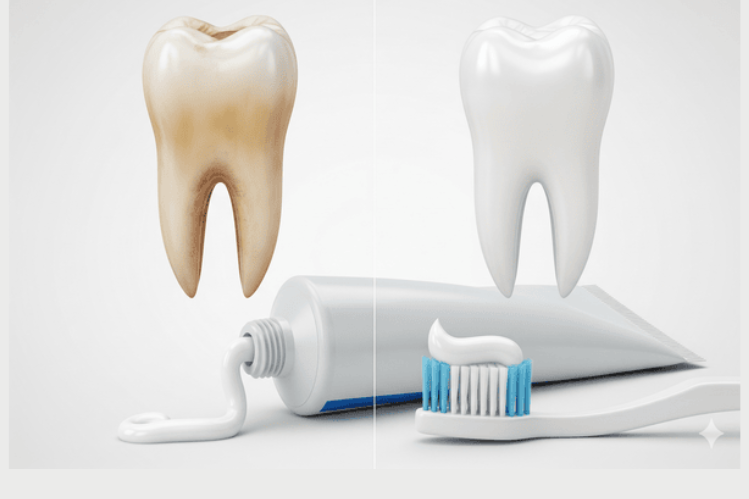
Table of Contents
- Why Whitening Toothpastes Can Cause Sensitivity
- What to Look for in the Best Whitening Toothpaste
- Best Whitening Toothpastes for Sensitive Teeth & Gums
- How to Whiten Sensitive Teeth Naturally
- Tips for Using Whitening Toothpaste Safely without Causing Sensitivity
- A Brighter Smile without the Sensitivity
- FAQs
A bright, white smile has a way of lighting up your whole face. But let’s be honest, not everyone wants to pay the price of tooth sensitivity for it.
Many formulas do a great job lifting stains, but they can also wear down enamel or irritate gums. That’s especially bad for people with existing sensitivity issues or those looking for teeth whitening for aging teeth .
The good news? You can get a dazzling smile with comfortable teeth. You don’t have to choose one of the two. Just look for the best toothpaste for whitening teeth without sensitivity. One that gently polishes away stains while keeping your enamel and gums happy.
So, what makes whitening toothpastes different? Which options work best for sensitive teeth, and are there any natural ways to whiten teeth? Let's figure all that out today.
Why Whitening Toothpastes Can Cause Sensitivity
A whitening toothpaste might be a shortcut to a movie-star smile. But it can leave your teeth feeling like they’ve just walked across an icy floor barefoot. Why, you ask? Let’s figure it out.
What Do Whitening Toothpastes Contain?
Most whitening toothpastes use either abrasive particles that scrub away stains or peroxide-based ingredients that penetrate the enamel to lift discoloration. Both are effective. But when they’re too strong or used too often, they may thin your enamel and expose tiny channels that lead to the inner layer of your teeth.
How Do Your Teeth React?
Once the enamel thins, that’s when you start feeling those sharp zaps with hot coffee or cold water. Your gums can also join the protest. The harsh whitening formulas irritate the delicate tissue of the gums. That, in turn, makes brushing uncomfortable.
Now, if whitening toothpastes can aggravate sensitivity, where should people with sensitive teeth go? Should they give up on whiter smiles? Not at all. All they have to do is just pick a formula that balances whitening power with tooth and gum protection.
What to Look for in the Best Whitening Toothpaste

What exactly should you look for when hunting down the best toothpaste for whitening teeth without sensitivity?
Check for Desensitizing Ingredients
Start by checking for desensitizing ingredients. See if the toothpaste contains Potassium Nitrate or Stannous Fluoride. The former calms the tiny nerve endings inside your teeth, while the latter protects against cavities, strengthens enamel, and provides a protective barrier.
Look for Gentle Whiteners
The most popular gentle whitener is hydrated silica. It lifts stains without scratching away precious enamel. Much like a soft polisher. However, there’s a more cutting-edge option available now. That is nano-hydroxyapatite (n-HAp). It is a natural mineral that actually helps rebuild enamel while brightening your teeth.
Be Cautious of Aggressive Ingredients
On the flip side, be cautious of formulas overloaded with hydrogen peroxide or aggressive abrasives. They may deliver fast results, but sensitivity is usually part of the package deal.
The takeaway? The best toothpaste for sensitive gums or teeth doesn’t just whiten. It protects, strengthens, and comforts. Think of it as a skincare routine for your smile: gentle yet effective.
Best Whitening Toothpastes for Sensitive Teeth & Gums

Now, let’s look at some of the best whitening toothpastes for sensitive teeth, ones that strike a balance between sparkle and sensitivity.
Sensodyne Brilliant Whitening
Sensodyne Brilliant Whitening is a classic. It strengthens softened enamel while removing surface stains. It keeps your smile bright without overdoing it. It’s perfect for people who want whitening power but need something safe for everyday use.
Colgate Sensitive Whitening
Colgate’s Sensitive Whitening is both budget-friendly and effective. It combines fluoride protection with a gentle stain-removal system. Thus, making it suitable for those with sensitive teeth and gums.
Crest 3D White Brilliance Gentle
Crest is known for its whitening products. However, not all of them are ideal for sensitive teeth. So, go for the “Gentle” line. With lower-abrasion polishing agents and fluoride protection, it brightens without the harshness of traditional whitening formulas. Think of it as the softer side of Crest’s whitening family.
Tom’s of Maine Antiplaque & Whitening
For those who prefer natural products, Tom’s of Maine offers a fluoride-free option that uses mild abrasives like calcium carbonate to lift stains. It doesn’t contain peroxide or artificial sweeteners. That makes it a solid choice if you want something simple and natural.
Hello Activated Charcoal Whitening Toothpaste
Charcoal has a bit of a reputation in oral care. And Hello has managed to make it gentle enough for sensitive teeth. Their formula combines activated charcoal with coconut oil and soothing aloe vera. The result? A refreshing, naturally derived whitening toothpaste that’s free from peroxide and artificial flavors.
Boka Ela Mint Toothpaste (Nano-Hydroxyapatite Formula)
If you want cutting-edge dental care, Boka’s toothpaste is a standout. And what makes it different is the use of nano-hydroxyapatite (n-Ha). It is a mineral that actually rebuilds enamel while reducing sensitivity. This Japanese-developed ingredient can naturally remineralize teeth, which makes it perfect for people who want to whiten while protecting enamel at the same time.
Which One Is Right for You?
So, what is the best toothpaste for whitening teeth without sensitivity? None, yet all. Actually, there can’t be a single answer to this question.
Different brands will work for different people. Just check the ingredients, do your research, consult a professional if you’d like to, and then buy the one that’s according to your requirements. Moreover, and quite importantly, remain consistent with its use. That’ll guarantee better, lasting results.
How to Whiten Sensitive Teeth Naturally

Some people just don’t like commercial products and want to go towards the natural way. They often ask how to whiten sensitive teeth naturally. And if it is possible at all.
Well, it is possible. Though it might take longer and require much more dedication than commercial products. But, if you’re ok with the commitment, here are the best natural methods to whiten sensitive teeth.
Oil Pulling
Oil pulling is the most commonly used method. Swish coconut oil around your mouth for 10–15 minutes a day. That’s it. This may help reduce surface stains and bacteria. It’s an age-old remedy that’s gentle on teeth and gums. Effectiveness, however, might be inconsistent.
Baking Soda
Another mild option is baking soda, but if used in moderation. Just mix a small amount in water and rinse your teeth with it. Baking soda can act as a soft polish, lifting stains without harming the enamel when used occasionally.
Diet
Diet definitely plays a role, though not directly. You can’t whiten your teeth with diet changes. But you can stop further yellowing after treatment. Or you can prevent yellowing if you adopt such changes before losing the sparkle. All it requires is cutting back on the foods that stain teeth after whitening . Meanwhile, eating crunchy fruits and vegetables ( apples, carrots, celery) can naturally scrub your teeth clean.
Soft, Gentle Brushing
Lastly, don’t underestimate the basics: a soft-bristled toothbrush and a gentle brushing technique can make a huge difference in preventing both staining and sensitivity.
Over time, these natural methods can help you get a whiter smile without the sting.
Tips for Using Whitening Toothpaste Safely without Causing Sensitivity
We’ve discussed several whitening products by now, highlighting what each brings to the table. That said, if it’s not used correctly, their effectiveness can be significantly reduced, or you can face increased sensitivity.
You need to balance whitening benefits with everyday protection. And how can you do that? By following these few smart tips:
- Use a soft-bristle toothbrush. Harsh bristles do more harm than good. And if your gums are already sensitive, they’ll worsen the situation. So, go for gentle brushing. It preserves enamel while still lifting stains.
- Don’t overdo it. Some people brush more than twice a day to get that white smile quicker. Or they scrub aggressively. But, they won’t make your teeth whiter. It just increases the risk of irritation. So, please avoid that. Use the whitening toothpaste only as advised.
- Alternate if needed. If you find sensitivity creeping back, switch between a whitening toothpaste and a desensitizing one to give your teeth a break.
- Be patient. Whitening toothpastes work gradually. Stick with consistent use, and you’ll notice brighter results over time without the discomfort.
- See your dentist regularly. Sometimes sensitivity isn’t just from toothpaste. It could signal enamel erosion, gum recession, or other dental issues. Get them ruled out if needed. Here’s more on Tooth Sensitivity: Causes, Treatment, and Prevention .
With these tips, a whitening toothpaste can enhance your smile without the frustrating sensitivity.
A Brighter Smile without the Sensitivity
A brighter smile, but at the cost of increased sensitivity. Nah, most of us won’t be comfortable with that. So, what options do we have?
The best toothpaste for whitening teeth without sensitivity. That’s our option. We can get our pearly whites back by using the one that fits our requirements. All without the sensitivity part. However, we need to remember that whitening isn’t a one-and-done fix. It’s a process that demands consistency.
All in all, there are plenty of teeth whitening options out there for sensitive teeth. It is not a far-fetched dream anymore.
FAQs
1. Which toothpaste is best for teeth whitening?
The best toothpaste for whitening teeth is one that balances stain removal with enamel protection. Brands like Sensodyne Pronamel Gentle Whitening, Colgate Sensitive Whitening, and Crest 3D White Brilliance Gentle can be excellent choices.
2. What is actually the best whitening toothpaste?
It depends on your needs. If you struggle with sensitivity, a formula with potassium nitrate or nano-hydroxyapatite (like Boka Ela Mint) is ideal. For natural care, Tom’s of Maine and Hello Activated Charcoal are solid picks.
3. Which toothpaste is best for whitening teeth in Canada?
In Canada, many of the same globally recognized brands are available, including Sensodyne, Colgate, and Crest.
4. Can yellow teeth turn white again?
Yes! Yellowing is often caused by surface stains from coffee, tea, or smoking, and the right whitening toothpaste can help lift those stains. However, if discoloration is deeper (under the enamel), professional whitening treatments may be needed.
Citations:
CNET. The Best Whitening Toothpastes for Sensitive Teeth, According to Dentists.
https://www.cnet.com/health/personal-care/best-whitening-toothpaste/
Health.com. The 8 Best Teeth Whitening Products for Sensitive Teeth, Tested and Reviewed.
https://www.health.com/beauty/best-whitening-products-sensitive-teeth
Forbes. The Best Whitening Products For Sensitive Teeth That Minimize Discomfort.
https://www.forbes.com/sites/forbes-personal-shopper/article/best-whitening-product-for-sensitive-teeth/





